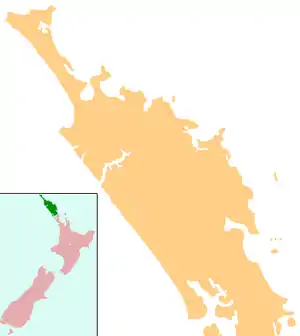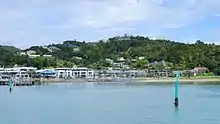Paihia
Paihia is the main tourist town in the Bay of Islands in the far north of the North Island of New Zealand. It is 60 kilometres north of Whangārei, located close to the historic towns of Russell and Kerikeri. Missionary Henry Williams named the mission station Marsden's Vale[2][3] and eventually the Paihia became the accepted name of the settlement.
Paihia | |
|---|---|
 Paihia  Paihia | |
| Coordinates: 35°16′56″S 174°5′28″E | |
| Country | |
| Region | Northland Region |
| District | Far North District |
| Population (June 2020)[1] | |
| • Total | 1,660 |
| Postcode(s) | 0200 |
Nearby to the north is the historic settlement of Waitangi, and the residential and commercial area of Haruru Falls is to the west. The port and township of Opua, and the small settlement of Te Haumi, lie to the south.
Demographics
| Year | Pop. | ±% p.a. |
|---|---|---|
| 2006 | 1,299 | — |
| 2013 | 1,290 | −0.10% |
| 2018 | 1,512 | +3.23% |
| Source: [4] | ||

Paihia had a population of 1,512 at the 2018 New Zealand census, an increase of 222 people (17.2%) since the 2013 census, and an increase of 213 people (16.4%) since the 2006 census. There were 561 households. There were 765 males and 750 females, giving a sex ratio of 1.02 males per female. Of the total population, 207 people (13.7%) were aged up to 15 years, 306 (20.2%) were 15 to 29, 654 (43.3%) were 30 to 64, and 345 (22.8%) were 65 or older. Figures may not add up to the total due to rounding.
Ethnicities were 69.0% European/Pākehā, 35.3% Māori, 3.6% Pacific peoples, 6.5% Asian, and 2.0% other ethnicities. People may identify with more than one ethnicity.
The percentage of people born overseas was 25.4, compared with 27.1% nationally.
Although some people objected to giving their religion, 50.2% had no religion, 35.9% were Christian, and 7.9% had other religions.
Of those at least 15 years old, 168 (12.9%) people had a bachelor or higher degree, and 210 (16.1%) people had no formal qualifications. The median income was $25,000. The employment status of those at least 15 was that 603 (46.2%) people were employed full-time, 219 (16.8%) were part-time, and 63 (4.8%) were unemployed.[4]
History and culture
Origin of the Name
The origin of the name "Paihia" is unclear. A popular attribution, most likely apocryphal, is that when Reverend Henry Williams first arrived in the Bay of Islands searching for a location for his mission station, he told his Māori guide, "Pai here," meaning "Good here," as his Māori vocabulary was limited. [5] [6]
European settlement

Henry Williams[3] and his wife Marianne[2] settled in Paihia in 1823 and built the first church there the same year. William Williams and his wife Jane joined the Paihia mission in 1826.[3] Bishop William Grant Broughton (the first and only Bishop of Australia) visited the Paihia mission in 1838 and performed several firsts in New Zealand including the first Confirmation and Ordination ceremonies.[7]
Herald was a 55-ton schooner that the missionaries built and launched off the beach at Paihia on 24 January 1826.[8][9][10]
In December 1832 the first mention of cricket being played in New Zealand was recorded by Henry Williams.[11] In 1835 a game of cricket was witnessed here by Charles Darwin,[12][13] in December 1835 while the Beagle spent 10 days in the Bay of Islands.[14][15]
In 1835 William Colenso set up the first printing press in New Zealand at Paihia.
In 1850 the mission closed and Paihia declined to a very small settlement by 1890.[16]
20th century
St. Paul's Anglican Church, completed in 1925, is the fifth church built on the site. It is constructed of stone quarried from the Pukaru locality, near Kawakawa and timber from near Waikare.[17] The triptych stained glass windows above the pulpit were commissioned by the Williams Family Trust in commemoration of Sir Nigel Reed for the 175 year family reunion and installed by the artist in 1998. The windows, titled Te Ara O Te Manawa (Pathway of the Heart) are 4 m2 in total size.
In 1926 a road was constructed to Puketona[18] on the main road from Kawakawa to Kerikeri (now State Highway 10) leading to an increase in tourism in the 1930s.[16]
Education
Paihia School is a coeducational full primary (years 1-8) school with a roll of 199 students as of March 2020.[19][20]
Climate
Köppen-Geiger climate classification system classifies its climate as oceanic (Cfb),[21] but it is rainier in winter. It has strong subtropical influence and is classified as such under the Trewartha system due to its consistent warm temperatures, and is the mildest weather station in New Zealand.
| Climate data for Paihia | |||||||||||||
|---|---|---|---|---|---|---|---|---|---|---|---|---|---|
| Month | Jan | Feb | Mar | Apr | May | Jun | Jul | Aug | Sep | Oct | Nov | Dec | Year |
| Average high °C (°F) | 24.6 (76.3) |
24.7 (76.5) |
23.4 (74.1) |
21.1 (70.0) |
18.6 (65.5) |
16.6 (61.9) |
15.8 (60.4) |
16.1 (61.0) |
17.2 (63.0) |
18.6 (65.5) |
20.6 (69.1) |
22.7 (72.9) |
20.0 (68.0) |
| Daily mean °C (°F) | 20.2 (68.4) |
20.4 (68.7) |
19.3 (66.7) |
17.2 (63.0) |
14.7 (58.5) |
12.8 (55.0) |
12 (54) |
12.3 (54.1) |
13.4 (56.1) |
14.8 (58.6) |
16.6 (61.9) |
18.4 (65.1) |
16.0 (60.8) |
| Average low °C (°F) | 15.8 (60.4) |
16.1 (61.0) |
15.2 (59.4) |
13.3 (55.9) |
10.9 (51.6) |
9.1 (48.4) |
8.3 (46.9) |
8.5 (47.3) |
9.7 (49.5) |
11.1 (52.0) |
12.6 (54.7) |
14.2 (57.6) |
12.1 (53.7) |
| Average precipitation mm (inches) | 98 (3.9) |
113 (4.4) |
128 (5.0) |
127 (5.0) |
131 (5.2) |
183 (7.2) |
164 (6.5) |
171 (6.7) |
132 (5.2) |
113 (4.4) |
96 (3.8) |
96 (3.8) |
1,552 (61.1) |
| Average rainy days | 9 | 9 | 12 | 12 | 13 | 15 | 17 | 16 | 15 | 13 | 11 | 10 | 152 |
| Mean daily sunshine hours | 7 | 6 | 5 | 5 | 5 | 4 | 4 | 5 | 5 | 6 | 7 | 7 | 6 |
| Source 1: Climate-Data.org (altitude: 0m)[21] | |||||||||||||
| Source 2: Weather2Travel for rainy days and sunshine[22] | |||||||||||||
| Jan | Feb | Mar | Apr | May | Jun | Jul | Aug | Sep | Oct | Nov | Dec |
|---|---|---|---|---|---|---|---|---|---|---|---|
| 21 °C (70 °F) | 21 °C (70 °F) | 21 °C (70 °F) | 20 °C (68 °F) | 18 °C (64 °F) | 17 °C (63 °F) | 16 °C (61 °F) | 16 °C (61 °F) | 16 °C (61 °F) | 16 °C (61 °F) | 18 °C (64 °F) | 19 °C (66 °F) |
Notes
- "Population estimate tables - NZ.Stat". Statistics New Zealand. Retrieved 22 October 2020.
- Caroline Fitzgerald (2004). Letters from the Bay of Islands. Penguin Books, New Zealand. ISBN 0-14-301929-5.
- Caroline Fitzgerald (2011). Te Wiremu - Henry Williams: Early Years in the North. Huia Press. ISBN 978-1-86969-439-5.
- "Statistical area 1 dataset for 2018 Census". Statistics New Zealand. March 2020. Paihia (103900). 2018 Census place summary: Paihia
- "New Zealand History - Paihia".
- "New Zealand Tourism Guide - Paihia History".
- Wises New Zealand Guide, 7th Edition, 1979. p.331
- Fitzgerald, Caroline (2011). Te Wiremu: Henry Williams – Early Years in the North. Huia Publishers, New Zealand. pp. 65–66. ISBN 978-1-86969-439-5.
- Fitzgerald, Caroline (2004). Marianne Williams: Letters from the Bay of Islands. Penguin Books, New Zealand. pp. 97–99. ISBN 0-14-301929-5.
- McLean, Gavin (20 July 2015). "Launching the Herald". 'Shipbuilding - The wooden era', Te Ara - the Encyclopedia of New Zealand. Retrieved 14 February 2017.
- SuperSport: New Zealand Cricket Team
- Todd, S. (1976) Sporting Records of New Zealand. Auckland: Moa Publications. ISBN 0-908570-00-7
- "Beginnings". teara.govt.nz.
- Charles Darwin, Journal of a Voyage Round the World, 1831-36
- Caroline Fitzgerald, (2011) Te Wiremu - Henry Williams: Early Years in the North p. 219-230
- "7. Paihia and Waitangi – Northland places – Te Ara Encyclopedia of New Zealand". teara.govt.nz.
- "St Paul's Anglican Church, Paihia, Bay of Islands".
- "Thumbnail History of Paihia - as a time-line". paihia.co.nz.
- "New Zealand Schools Directory". New Zealand Ministry of Education. Retrieved 26 April 2020.
- Education Counts: Paihia School
- "Climate: Paihia - Climate graph, Temperature graph, Climate table". Climate-Data.org. Retrieved 2014-01-20.
- "Paihia Climate and Weather Averages, New Zealand". Weather2Travel. Retrieved 2014-01-20.
External links
| Wikivoyage has a travel guide for Paihia. |
| Wikimedia Commons has media related to Paihia. |
